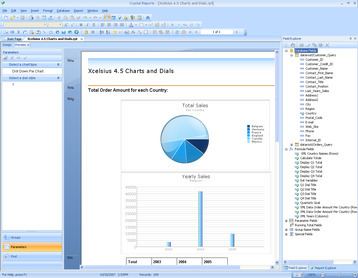Type Reporting software Website www.crystalreports.com | Operating system License Trialware | |
 | ||
Available in Chinese (Simplified), Chinese (Traditional), English, French, German, Italian, Japanese, Korean, Spanish | ||
Crystal Reports is a business intelligence application, currently marketed to small businesses by SAP SE. It is used to design and generate reports from a wide range of data sources.
Contents
History
Terry Cunningham and the Cunningham Group originated the software in 1991. Crystal Services Inc. marketed the product (originally called "Quick Reports") when they couldn't find a suitable commercial report writer for their accounting software. After producing versions 1.0 through 3.0, Crystal Services was acquired in 1994 by Seagate Technology. Crystal Services was combined with Holistic Systems to form the Information Management Group of Seagate Software, which later rebranded as Crystal Decisions and produced versions 4.0 through 9.0. Crystal Decisions was acquired in December 2003 by BusinessObjects, which produced versions 10, 11 (XI) and version 12 (2008). SAP acquired BusinessObjects on October 8, 2007 and released Crystal Reports 2011 (version 14) on May 3, 2011.
Several other applications, including Microsoft Visual Studio versions 2003 through 2008, and Borland Delphi, at one time bundled an OEM version of Crystal Reports as a general purpose reporting tool. Microsoft discontinued this practice and later released their own competitive reporting tool, SQL Server Reporting Services (SSRS).
Versions and Editions
Report designer
Crystal Reports allows users to graphically design data connection(s) and report layout. In the Database Expert, users can select and link tables from a wide variety of data sources, including Microsoft Excel spreadsheets, Oracle databases, Microsoft SQL Server databases, Microsoft Access databases, BusinessObjects Enterprise business views, and local file-system information. Report designers can place fields from these sources on the report design surface, and can also deploy them in custom formulas (using either BASIC or Crystal's own syntax), which are then placed on the design surface. Formulas can be evaluated at several phases during report generation as specified by the developer.
Both fields and formulas have a wide array of formatting options available, which designers can apply absolutely or conditionally. The data can be grouped into bands, each of which can be split further and conditionally suppressed as needed. Crystal Reports also supports subreports, graphing, and a limited amount of GIS functionality.
Central Management Server
The Central Management Server (CMS, formerly "Crystal Management Server") operates as the main server for BusinessObjects XI.
Supported data sources
Target audience
Crystal Reports became integrated with Visual Studio versions prior to 2010. Crystal Reports competes with several products in the Microsoft market, such as SQL Server Reporting Services, XtraReports, ActiveReports and List & Label. Users can also access Crystal Reports from outside of Microsoft environments; this allows (for instance) Java developers to build applications with Crystal Reports components.
